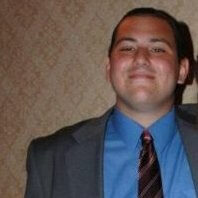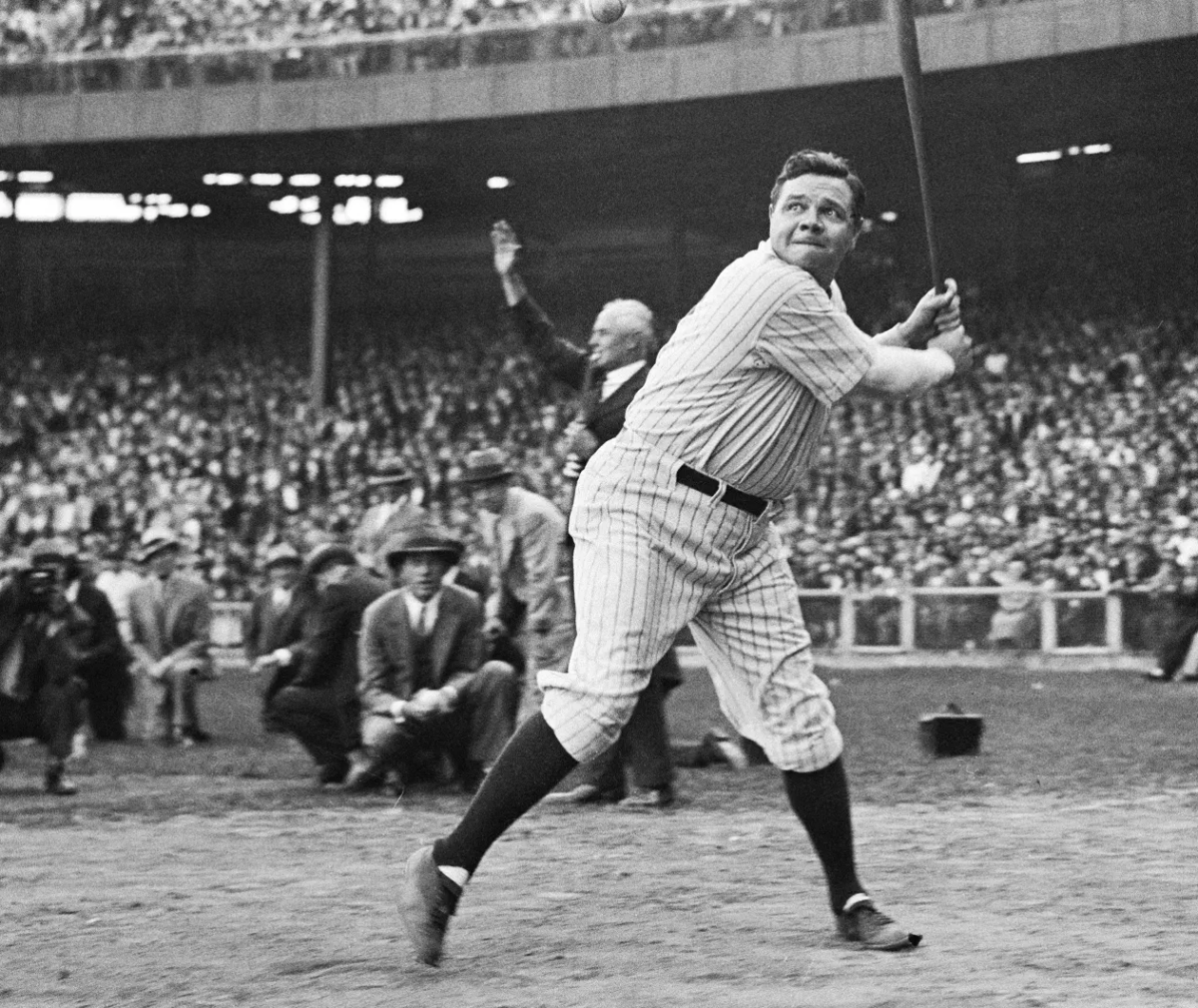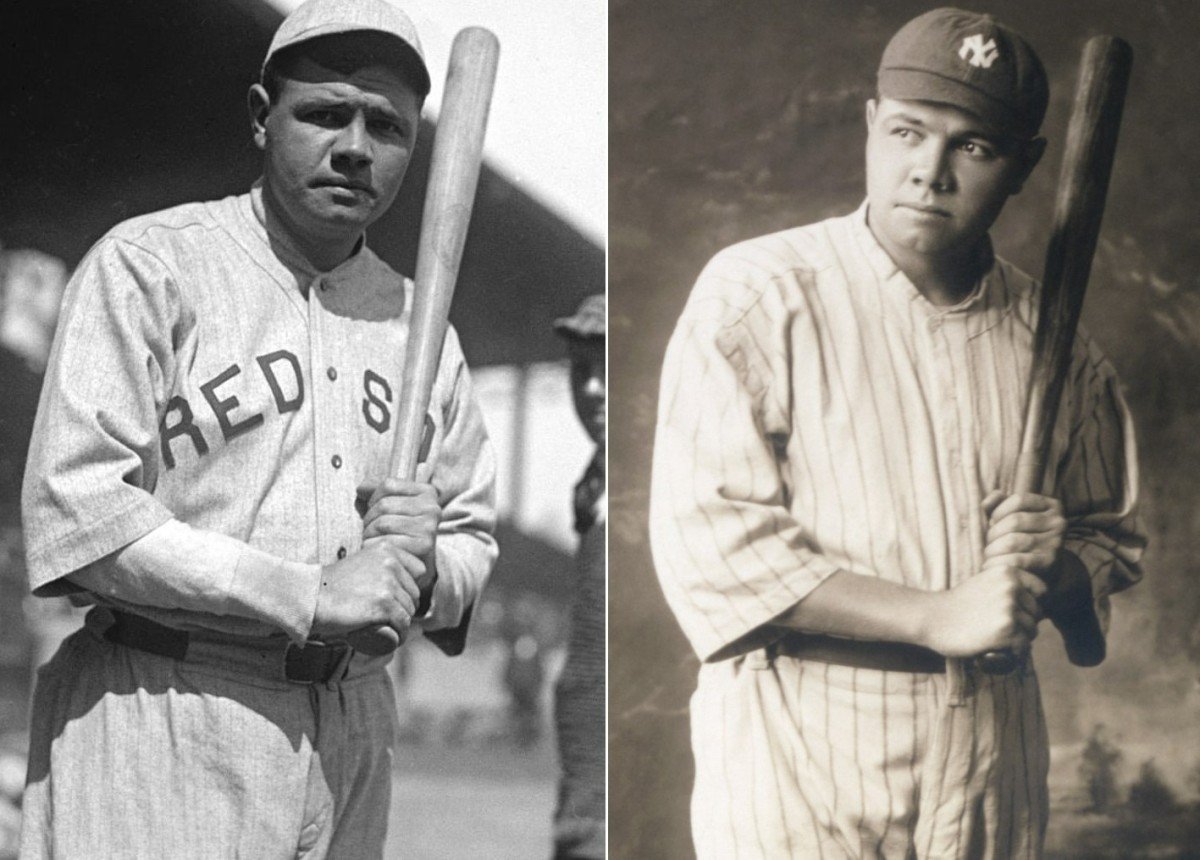The Ruth-less deal 104 years ago: Red Sox sold Babe Ruth to Yankees for $25,000

Matthew Maybloom
More Stories By Matthew Maybloom
- Mother’s Day: How Anthony Volpe’s mom molded him into a Yankee phenom
- 470-Foot Bomb: Aaron Judge sets career record despite Yankees’ loss to Red Sox
- Giancarlo Stanton to rejoin Yankees for Phillies series opener on Monday
- Yankees’ top prospect Jasson Dominguez nears return after oblique injury
- Rich Hill draws Yankees’ attention for midseason signing
- December 26, 2023
- 9:33 am
- No Comments
Table of Contents
December 26 remains a historic day for the Yankees, as they acquired Babe Ruth on this day 104 years ago from the Red Sox for a sum of $25,000. While this transaction, occurring in 1919, famously provided the Yankees with arguably the greatest baseball player in history, the Red Sox suffered from the “Curse of the Bambino” until 2004.
The equivalent of $25,000 in 1919 would be just under $450,000 in today’s terms—approximately what the Yankees recently paid to sign 17-year-old Dominican prospect Justin Capellan this December.
The reason behind the Yankee-Red Sox Deal
Legend has it that the cash received served as the initial capital required by then-Red Sox owner Harry Frazee to fund a new play.
During the initial months of 1919, the Red Sox seemed to be enjoying a period of stability and success. Beneath this veneer, however, financial troubles loomed, casting a shadow over the Boston club’s future. Despite a victorious season in 1918, a significant decline in attendance during the waning days of wartime caused a 35 percent drop in the club’s gate receipts. Concurrently, club owner Harry Frazee faced financial setbacks stemming from challenges with his theatrical productions in New York.

In the midst of these challenges, the team’s most beloved player started to believe that his value surpassed his current compensation. In January 1919, Babe Ruth insisted on a new contract, explicitly seeking to elevate his annual salary from $7,000 to $15,000—a sum comparable to the renowned Ty Cobb’s earnings at that time. Additionally, he expressed a desire to exclusively play left field, stating to the press, “I’ll contribute more to winning games by playing in the outfield every day than I would by pitching every fourth day.”
Frazee dismissed Babe Ruth’s demands with disdain, leading to his holdout and becoming a prominent headline in local newspapers. However, when the team embarked on its journey to Spring Training in Florida, with a lucrative exhibition series lined up against John McGraw’s Giants and the absence of their star player, both parties sensed the need to negotiate. Just weeks before Opening Day, Frazee and Babe Ruth reached an agreement for a $10,000 annual salary.
Yet, as Babe Ruth went on to set a new home run record with 29 blasts in 1919, it became evident that the newly inked three-year contract would not endure. That winter, Yankees owners Jacob Ruppert and Tillinghast Huston presented a deal to the financially strained Frazee, a proposal he deemed irresistible. This pivotal moment set in motion what is arguably the most renowned sale in the history of sports.
The Babe Ruth Deal
A snapshot of the agreement, shared in a 2013 tweet, reveals an interesting detail: someone handwritten added “cash” in the deal after the mention of $25,000.
On this date in 1919, the @RedSox sold Babe Ruth's contract to the @Yankees. pic.twitter.com/hUbLq2S3ew
— Cut4 (@Cut4) December 26, 2013
This promissory note, housed in the Hall of Fame Library Archive, records a transformative agreement that significantly impacted the destinies of two of baseball’s most renowned franchises. The terms of Babe Ruth’s sale to the Yankees, valued at a then-staggering $100,000, unfolded as follows: Ruppert and Huston provided Frazee with an upfront cash payment of $25,000, accompanied by three promissory notes, each slated for payment on November 1 in the subsequent three years.
A promissory note is a legally binding document wherein one party (in this instance, Ruppert and Huston) commits to making a payment to the other party (Frazee) on a predetermined date in the future. The note preserved in the Hall of Fame archive, adorned with the signatures of all three team owners, specifically pertains to the initial scheduled payment on November 1, 1920.
National Baseball Hall of Fame Library
As per Babe Ruth biographer Robert W. Creamer, each of the promissory notes carried a six percent interest rate, effectively translating to the Yankees disbursing a sum closer to $110,000 to the Red Sox. Additionally, Ruppert committed to extending a further loan of $300,000 to Frazee. In return, the Yankee owner secured a mortgage on Boston’s Fenway Park—a facet described by Creamer as a crucial element of the agreement.
A meticulous examination also unveils the date on this specific promissory note as December 26, 1919—the day the owners formalized the deal. They opted to defer the announcement to the press until Babe Ruth consented to the terms, introducing an added layer of complexity to the proceedings.
National Baseball Hall of Fame Library
An interesting but secret deal
At the time the deal was sealed, Babe Ruth was not in Boston; instead, he found himself in California. While Ruppert and Huston negotiated terms with Frazee, they dispatched manager Miller Huggins to Los Angeles to engage in discussions with Babe Ruth. According to Creamer’s book, “Babe: The Legend Comes to Life,” after encountering initial difficulties, Huggins eventually located the slugger on a golf course. Initially, Babe Ruth insisted on an unprecedented $20,000 salary and a share of Ruppert’s cash payment to Frazee. Over time, Huggins succeeded in persuading the player to settle for $10,000, supplemented by an additional $21,000 in bonuses to be disbursed regularly throughout the 1920 and 1921 seasons.
The announcement of Babe Ruth’s sale to the press on January 5, 1920, 11 days after the initial agreement, triggered a range of emotions, from despair in Boston to excitement in New York. However, it also foreshadowed the burgeoning public interest in the escalating salaries of players—an issue that would come to define labor negotiations in baseball for many decades.

In an attempt to diminish the impact of the sale, Frazee sought to portray Babe Ruth as “selfish” to the press, characterizing the Yankees’ acquisition as a “gamble.” However, considering that the Yankees eventually shelled out nearly half a million dollars for the slugger—factoring in the original sale, the loan to Frazee, Babe Ruth’s annual salary, and subsequent bonuses—it is fair to conclude in hindsight that the perceived “gamble” paid off handsomely, leading to imminent World Series championships and enhanced prestige for the Yankees.
A landmark deal that redefined the game
Regardless of the dramatization, the trade aligned with the shift in MLB equipment policy that marked the end of the Deadball Era. Babe Ruth emerged as the preeminent home-run hitter, coinciding with a time when people began to truly appreciate the significance and excitement of home runs. Babe Ruth had already set a Major League home-run record with 29 while with the Boston team in 1919. Subsequently, he shattered his own record by hitting 54 in 1920 and an astonishing 59 in 1921. With Babe Ruth in their ranks, the Yankees secured World Series victories in 1923, 1927, 1928, and 1932.
The reverberations of this historic trade would echo through generations, reshaping the fortunes of both the Red Sox and the ascending Yankees franchise. Babe Ruth’s arrival marked a transformative era, as Babe Ruth astoundingly set MLB records by hitting 50-plus home runs in each of his first two years with the Yankees, never falling below 25 in any subsequent season. His impact extended beyond the confines of the baseball field; Babe Ruth transcended into a cultural phenomenon, attaining a level of superstardom and celebrity unprecedented in the sport.

His immense popularity not only set all-time attendance records but also paved the way for the Yankees to depart from the Polo Grounds, ultimately constructing their iconic stadium—Yankee Stadium—solidifying a new era in baseball history.
Yankee Stadium earned the moniker “The House that Ruth Built” as a testament to Babe Ruth’s monumental impact, with the majority of the revenue he generated contributing to the construction of the stadium. However, the true marvel of his tenure with the Yankees lay in the cultural transformation he spearheaded within the franchise. Prior to his arrival, the Yankees had never secured any championship, while the Red Sox stood as the most successful team of the 20th century up to that juncture. The narrative, however, underwent a profound shift following the trade.
Babe Ruth’s leadership propelled the Yankees to seven American League Pennants and four World Series titles. He played a pivotal role in assembling the legendary “Murderers’ Row,” arguably one of the greatest lineups ever crafted. Comprising future Hall of Famers like Lou Gehrig, Earle Combs, Mark Koenig, Bob Meusel, Tony Lazzeri, and Babe Ruth himself, this formidable lineup set a new standard, with the slugger personally achieving the remarkable feat of hitting 60 home runs—a record that stood for decades.
Reflecting on this transaction, it has earned the infamous moniker “The Curse of the Bambino,” and with good reason—it stands out as one of the most ill-fated trades/sales in the annals of sports history. Babe Ruth, widely regarded as the greatest baseball player of all time and the inaugural inductee into the 1936 Baseball Hall of Fame in Cooperstown, New York, left an indelible legacy as a living legend.
However, beyond Babe Ruth’s personal legacy, the true impact of this trade lies in the divergent paths these two teams took afterward. This trade marked the onset of the curse haunting the Red Sox franchise, enduring an 85-year championship drought, often attributed to the departure of Babe Ruth. In stark contrast, the Yankees flourished, securing 39 pennants and 26 World Series titles during this period—more than double the tally of any other team. The curse persisted until 2004 when the Red Sox orchestrated a historic comeback in the American League Championship Series against the Yankees, overcoming a 3-0 deficit to win the series 4-3 and subsequently clinching the World Series in just four games. This triumph, breaking the curse, marked a pivotal moment in sports history—the only 3-0 comeback in baseball history and the Red Sox’s first championship since the Babe Ruth trade.
In essence, the magnitude of this trade was astronomical, reshaping the trajectory of baseball history and catalyzing the ascent of the most successful North American sports franchise. Simultaneously, it ushered in over 80 years of suffering for Boston sports fans, making the exchange of Babe Ruth one of the most—if not the most—lopsided trades in the annals of sports history.
What do you think? Leave your comment below.



 Follow Us
Follow Us









